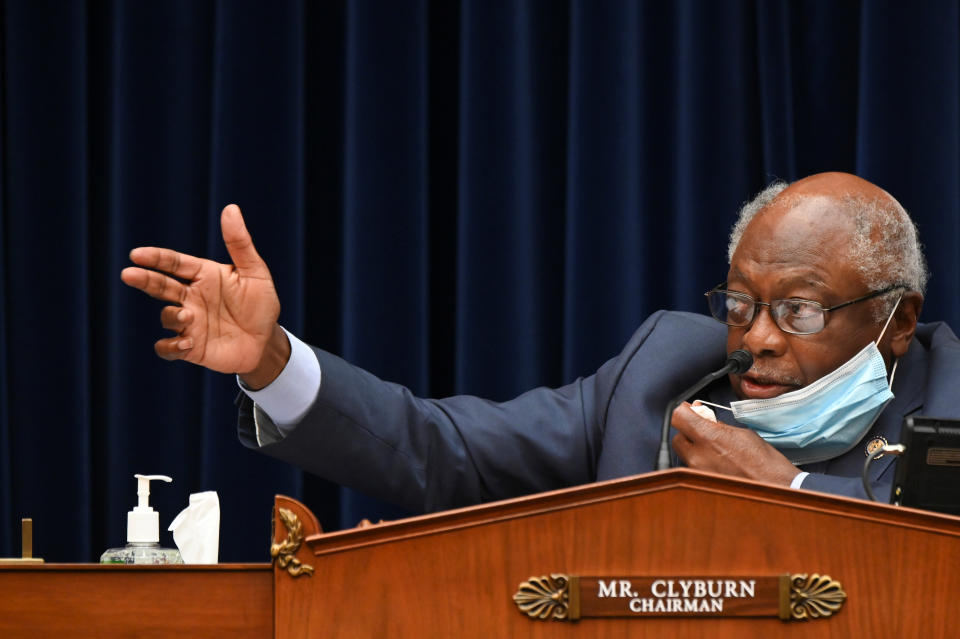White House ignored warnings as it pushed for reopenings, newly released coronavirus task force reports show
WASHINGTON — Even as President Trump spurred states to lift lockdown measures and resume normal economic activity in the early summer, reports from his own White House coronavirus task force were presenting regular evidence that infections were rising in many parts of the country. Critics have maintained that by not acting on evidence that the virus was not in remission, Trump and his advisers only prolonged the nation’s battle with the pandemic, which has killed more than 180,000 Americans to date.
The task force reports are customarily not made public, but eight of them from June and July had been requested late last month by the coronavirus subcommittee of the House Oversight Committee. The subcommittee is headed by Rep. James Clyburn, D-S.C., a leading House Democrat who is also a close ally of Joe Biden, the Democratic nominee for president. Biden has made the absence of a national plan to deal with the coronavirus a centerpiece of his campaign.
“Rather than being straight with the American people and creating a national plan to fix the problem,” Clyburn said in a statement on Monday morning, “the President and his enablers kept these alarming reports private while publicly downplaying the threat to millions of Americans.”
The White House did not respond to a request for comment.

The administration aggressively pushed to reopen the nation as early as possible, after a spring of crippling lockdowns in which some 30 million Americans lost their jobs. At one point, as the virus continued to devastate the Northeast, Trump mused that he would like the country reopened by Easter, which this year fell on April 12. But the date came and went without states emerging from their lockdowns.
The administration tried again several weeks later, as cases in and around New York City — which had been the pandemic’s epicenter in March — fell rapidly. On June 16, Vice President Mike Pence published an op-Ed in the Wall Street Journal titled “There Isn’t a Coronavirus ‘Second Wave.’” The sub-headline neatly summarized his argument: “With testing, treatments and vaccine trials ramping up, we are far better off than the media report.”
But by then the virus had moved on to the Sun Belt. According to the newly released coronavirus task force reports, this was made clear to the president. The report that the task force disseminated a week later clearly showed rising case counts and test positivity rates in Texas, Alabama, Florida, South Carolina and Arizona. Soon all of those states would be coronavirus hot spots. (The reports include an analysis of each state’s situation, as well as a national overview.)
The White House task force included Drs. Anthony Fauci and Deborah Birx, both respected veterans of the 1980s fight against HIV/AIDS. But while Fauci urged a cautious reopening, Birx presented the president with arguments in favor of reopening more quickly. Trump was also being prodded by economic advisers like Larry Kudlow (a member of the task force) and Peter Navarro to reopen as quickly as possible, lest the economic downturn continue.

And yet the newly public state-by-state reports from June and July plainly show that, even as the virus receded in the Northeast, in large part because of the severe lockdown measures imposed by governors like Andrew Cuomo of New York and Phil Murphy of New Jersey, it had migrated elsewhere.
The report for June 29, for example, again showed the virus surging through much of the Southeast and the South. By July 19, the task force listed 20 states as experiencing “red zone” viral outbreaks. Florida, Georgia and South Carolina, where Republican governors had rushed to reopen in order to please Trump, proved especially concerning to the task force.
The reports were shared with state-level authorities. It is not clear who in the White House reviewed them, though Pence sometimes held calls with governors. On one such call, he incorrectly told governors that case counts were rising because more people were receiving diagnostic tests.
Trump is not known as a reader, and daily intelligence briefings have to be presented to him in an easily digestible format in order to keep his attention. His public statements indicate that he had lost interest in dealing with the virus by June and sought to declare the disease over and resume his beloved campaign rallies.
Trump did take a more serious approach to the virus in late July, as the realities warned about in the task force reports became apparent to him and the rest of the country. “Some areas of our country are doing very well,” he said during an uncharacteristically somber press briefing on July 21, “others are doing less well. It will probably, unfortunately, get worse before it gets better — something I don’t like saying about things, but that’s the way it is.”

The tone did not last. More important, Trump’s seemingly renewed dedication to the virus did not lead him to follow the recommendations contained in the task force reports, or to urge governors to do so.
For example, as the situation worsened in Florida, the task force urged the state to adopt a universal mandate, especially in hot-spot counties. Trump did not push Gov. Ron DeSantis to implement that measure, and when Pence visited Florida in early August he did not do so either, electing to praise DeSantis instead for his “leadership” and “professionalism.”
Since then, 5,187 people have died in Florida from the coronavirus.
This article has been updated to more accurately describe how the task force reports were disseminated to individual states.
_____
Read more from Yahoo News:



